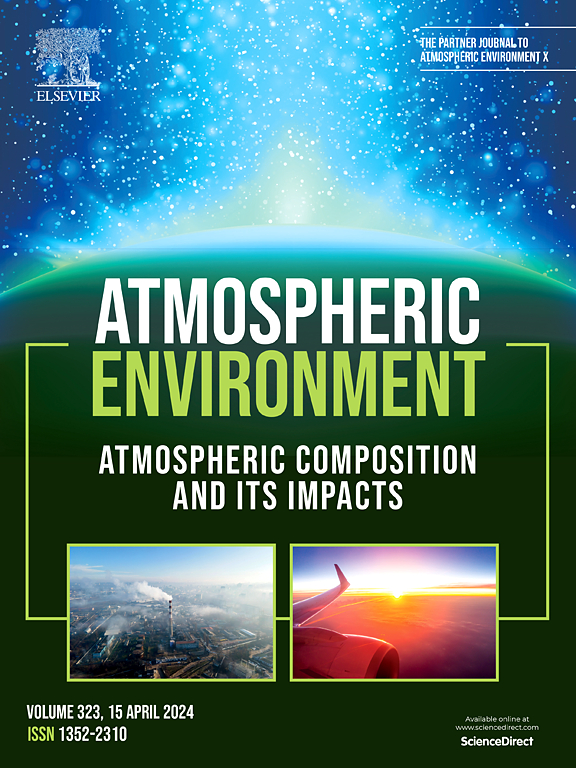Product and mechanistic insights into the ozonolysis of Δ3-Carene
IF 3.7
2区 环境科学与生态学
Q2 ENVIRONMENTAL SCIENCES
引用次数: 0
Abstract
This study combines experimental and theoretical approaches to investigate the gas-phase ozonolysis of Δ3-carene, with a focus on product identification and mechanistic elucidation. Atmospheric ozonolysis was simulated using both a Teflon chamber and a jet-stirred reactor. Product characterization was achieved through vacuum ultraviolet photoionization mass spectrometry employing soft ionization techniques, combined with Hefei synchrotron radiation to acquire mass-selected photoionization efficiency spectra of Δ3-carene and its ozonolysis products. Structural assignments were then facilitated by theoretical calculations conducted at the M06-2X/6–311++G(d,p) level of theory. Our analysis revealed many characteristic ozonolysis products, such as formaldehyde (CH2O, m/z = 30), acetone (C3H6O, m/z = 58), nor-3-caronaldehyde (C9H14O2, m/z = 154), nor-3-caralic acid (C8H12O3, m/z = 156), 3-caronaldehyde (C10H16O2, m/z = 168), 3-caralic acid (C9H14O3, m/z = 170), and 3-caronic acid (C10H16O3, m/z = 184). Moreover, the ozonolysis products, C8H12O2 (m/z = 140), C8H14O2 (m/z = 142), C10H16O (m/z = 152), and C10H14O3 (m/z = 182) were identified in the experiments for the first time. Based on literature results and comprehensive analysis of the experimental data, we elucidated detailed reaction pathway mechanisms for these newly discovered products.

Δ3-Carene臭氧分解的产物和机理
本研究结合实验和理论方法研究Δ3-carene的气相臭氧分解,重点是产品鉴定和机制阐明。采用聚四氟乙烯室和喷射搅拌反应器模拟了大气臭氧分解。通过采用软电离技术的真空紫外光电离质谱法对产物进行表征,并结合合肥同步辐射获得Δ3-carene及其臭氧分解产物的大量选择光电离效率谱。然后,在M06-2X/ 6-311 ++G(d,p)理论水平上进行理论计算,促进了结构分配。我们的分析发现了许多典型的臭氧分解产物,如甲醛(CH2O, m/z = 30)、丙酮(c3h60, m/z = 58)、无-3-碳醛酸(C9H14O2, m/z = 154)、无-3-碳醛酸(C8H12O3, m/z = 156)、3-碳醛酸(C10H16O2, m/z = 168)、3-碳醛酸(C9H14O3, m/z = 170)和3-碳醛酸(C10H16O3, m/z = 184)。实验中首次鉴定出臭氧分解产物C8H12O2 (m/z = 140)、C8H14O2 (m/z = 142)、C10H16O (m/z = 152)和C10H14O3 (m/z = 182)。根据文献结果和对实验数据的综合分析,我们详细阐述了这些新发现产物的反应途径机制。
本文章由计算机程序翻译,如有差异,请以英文原文为准。
求助全文
约1分钟内获得全文
求助全文
来源期刊

Atmospheric Environment
环境科学-环境科学
CiteScore
9.40
自引率
8.00%
发文量
458
审稿时长
53 days
期刊介绍:
Atmospheric Environment has an open access mirror journal Atmospheric Environment: X, sharing the same aims and scope, editorial team, submission system and rigorous peer review.
Atmospheric Environment is the international journal for scientists in different disciplines related to atmospheric composition and its impacts. The journal publishes scientific articles with atmospheric relevance of emissions and depositions of gaseous and particulate compounds, chemical processes and physical effects in the atmosphere, as well as impacts of the changing atmospheric composition on human health, air quality, climate change, and ecosystems.
 求助内容:
求助内容: 应助结果提醒方式:
应助结果提醒方式:


